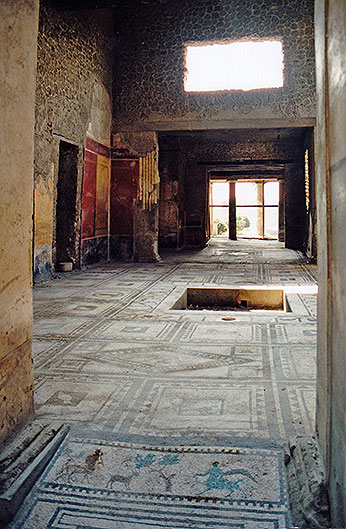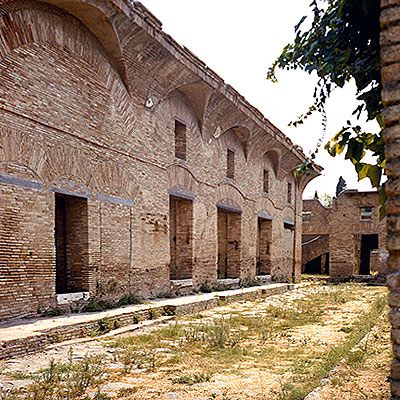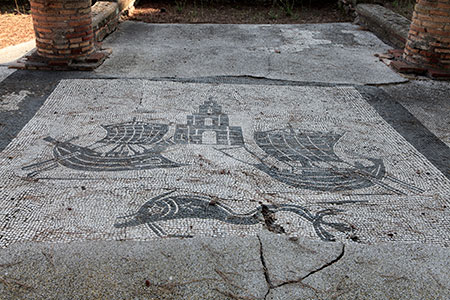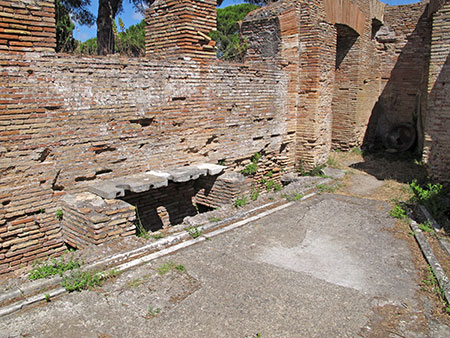By Gerard Huissen

Two different cities
Ostia and Pompeii are without question the two best preserved towns from Roman times, but that’s where the comparison ends. Immediately after Pompeii had been rediscovered and excavated in the 18th century it attracted numerous visitors from all over the world.
Ostia, by contrast, only became widely known after the rail link between Rome and the coast was opened in 1923, making the town easier to reach. Until that time travelling to Ostia was a laborious affair along poorly negotiable tracks through an area infested by malaria.
By then Pompeii had already been largely excavated and restored, so that visitors got to see a complete town with theatres, shops, temples, houses and much else besides. Ostia was much smaller than Pompeii and consisted at that time of little more than a few walls poking out above ground level.

Although Roman houses, as described in the first century A.D. by the poets Martial and Juvenal, in no way resembled the houses in Pompeii, they were nevertheless long regarded as such – even well after Ostia had been excavated, and even though the houses here did correspond with the ancient description from the days of the Roman Empire.
Ostia is no Pompeii
The cities differ both historically and in terms of character. Pompeii had already long been in existence before being absorbed into the Roman Empire and was in fact an Oscan town whose inhabitants spoke an Oscan language. The city had many Greek influences, although the Greeks themselves never lived there.
From 524 – 474 the town was occupied by the Etruscans. In 242 Pompeii was captured by the Samnites, who radically rebuilt the town as it is now. In terms of construction and politics the city was established on a totally different basis from Roman towns.
In 90 BC Pompeii sided with the other Samnite towns in an uprising against the colonisation by Rome. The town was defeated in a lengthy struggle, known as the “Social War”, by the Roman general and statesman Sulla and came under Roman control. At that time Oscan was spoken in Pompeii instead of Latin. Sulla left behind a large military force in Pompeii, as a result of which the town rapidly came under the influence of all sorts of Roman influences, nevertheless remaining a Romanised rather than Roman town. Over the course of time Oscan also became replaced by Latin.
Pompeii remained a rural town where life was agreeable. A lot of money was earned from agriculture, but also spent again straight away. Politically Pompeii did not play a role of any significance in the Roman Empire.

Ostia by contrast was a genuine Roman establishment, as we saw in ‘A Harbour for Rome’. Ostia was vitally important for Rome, and Rome for Ostia. The town consequently achieved great heights at the same time as Rome. In order to get an idea of what ancient Rome looked like one needs to visit Ostia. While it is true that temples, baths and amphitheatres, etc., are best seen in Rome, more prosaic buildings and ordinary dwellings have largely disappeared in the city. These days it is difficult to imagine how ordinary life in Rome must once have been.
Ostia, however, does give us a good idea of daily life at that time, with bars, shops, storerooms and workplaces. The houses – of which some two and even three story buildings are still in evidence – differ totally from those in Pompeii and match the descriptions of Juvenal and Martial precisely. In particular, the urban layout of the second century provides the best impression of a Nova Urbs (new city) as created in Rome by Nero after the great fire of 64.

Of the large number of warehouses at the foot of the Aventinus in Rome just one remains.
In Ostia, by contrast, the complete floor plan and design may be seen for the storage of grain, or oil and other products.
At the Piazzale delle Coporazioni – the large formerly covered square behind the theatre – many of the overseas ports with which Rome traded are depicted. The ports of Claudius and Trajan allow us to see the perfect organisation with which more than a million people in Rome were fed. If we want to know how public services such as the fire brigade and city security operated in Rome, we need to look at the Caserma dei Vigili in Ostia.
At the same time, Ostia also had its own distinctive character. It was not just a seaport for Rome. Warehouses and shops alternated with temples, basilicas, baths, theatres and other public buildings. As well as that facilities were required for the crews of the ships plying the ports. Vessels needed to be not only loaded and unloaded but also to be provisioned. As such, a seaport had a separate social environment of its own.

Modern archaeologists continue to this day to work out how daily life in a seaport of this kind must have been. How did foreigners who moored there know where to find accommodation, a baker or a physician in the town? How did they find their way about? Was there the equivalent of a tourist office? (See the ‘Travertine cornerstone’video). The big difference between Ostia and Pompeii therefore relates to the origins and character of the two cities. Life in Pompei came to an end in 79.
Ostia as we know it today dates from the second century, with all sorts of modifications in later centuries. At the same time, research has indicated that the differences during the republican era were less pronounced. Pompeii came to lie under a thick layer of ash and it would seem that nobody felt the need to dig the town out again straight away. Instead it lay forgotten and remained intact until it was rediscovered, excavated and restored, thereby providing us with a snapshot of how the town looked in 79. Ostia by contrast experienced the great flowering and decay of the Roman era and died a slow death after it was deserted. It was still often used for quarrying or as a treasure trove. Present-day Ostia is more or less a lived-in copy of what Rome once was.
Translated by Jan Ariens (London)
Sources
"Roman Ostia" by Russell Meiggs; Oxford at the Clarendon Press; second edition 1973
"Pompéi, la cité ensevelie" by Robert Etienne; 1988, Gallimard, Paris






 We are committed to providing versions of our articles and interviews in several languages, but our first language is English.
We are committed to providing versions of our articles and interviews in several languages, but our first language is English.